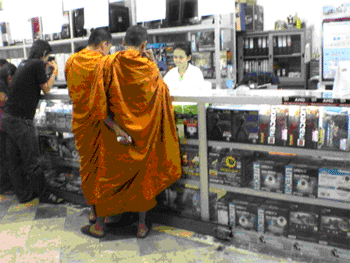Surrounded: A Study in Ubiquitous Computing Technology
| Amanda Williams is a third-year graduate student in information and computer sciences and a Calit2 student researcher at UCI. In 2005, she was the recipient of a prestigious three-year NSF Graduate Research Fellowship that funded her travel to Thailand to investigate ubiquitous computing. She returned to Thailand in June to complete her research. |
|
Irvine, Calif., July 11, 2007 --Ubiquitous computing is the creation and deployment of computing technology in such a way that it becomes an invisible part of the fabric of everyday life. Its technologies are deployed into diverse social, cultural, political and geographic settings, and incorporated into many different forms of personal and collective mobility. The varied mobilities of the jet setter, migrant worker, goat herder or university student lend different uses and meanings to computational devices and technological infrastructures.
I explored this idea last summer while interning with the People and Practices Research Lab at Intel Research in Portland, Ore. I conducted a three-month multi-site ethnography on the particular mobile practices of transnational Thai retirees. The study included 19 retirees and four of their children. Most own a home in both countries and travel between the two approximately yearly, maintaining important ties in both locations.
My study focused on concepts of distributed “home,” collaboration between family members across continents and within a city, and how ordinary people use technology to achieve personal and cultural values. Besides interviewing my subjects, I visited their homes, staying overnight or for several days when possible, and occasionally traveled with them. Interviews and home visits took place in and around Seattle, St. Louis, rural Illinois and New York in the United States, and Bangkok and Chantaburi in Thailand.
One of the major conclusions I drew from this study is that distance matters, but not always in the ways we think it does. Rather than thinking about how communication technologies solve (or don’t) the problem of distance, a more productive framing might focus instead on distribution, and how certain locations can help people better fulfill a role they have taken on, or help their family or make certain resources available. For example, having a relative in Bangkok or New York may be as valuable as good grades or high income in opening up opportunities for higher education.
|
Another finding: location matters. Identical devices in different social settings take on very different meanings and are appropriated differently into people’s practices. Our participants regarded mobile phones as a natural fit for a Thai lifestyle in a way that is not quite true of the U.S. lifestyle. The key to this fit lies in the differences between social infrastructures in the two locations.
In Thailand, local networks of exchange were denser and more readily available, constantly in the background, an important resource for navigating the world, and a major source of authoritative knowledge. Communication technologies like cheap telephony and email make that social infrastructure even more readily available, and mobile phones make it available even when one is about town, allowing people to cope with unreliable urban infrastructure, chronic traffic jams and missed transit connections.


